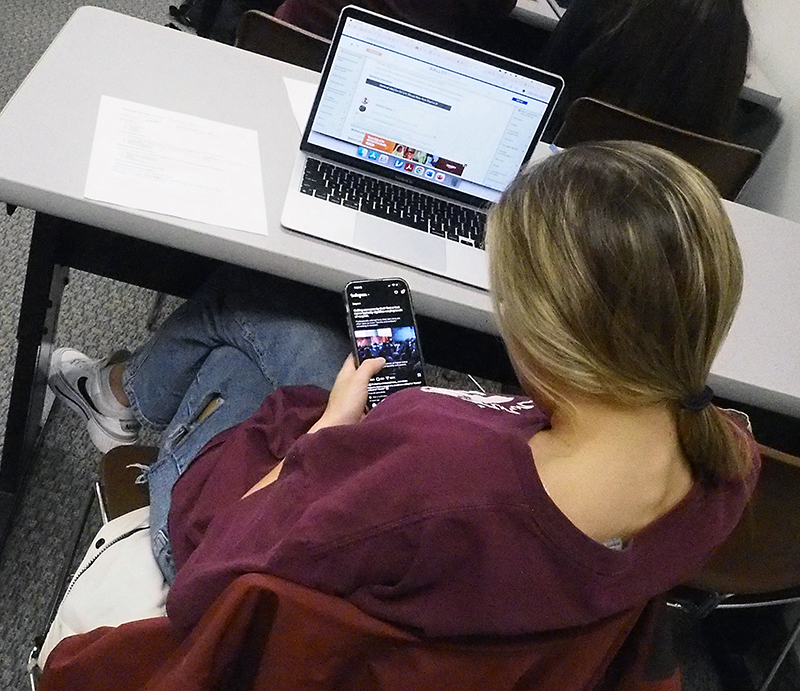by Katie Miller
In a time of constant connectivity in the digital world, the idea of relaxation has become significantly different. There was an era when relaxation meant really stepping away from work and all other outside noise. Whether it meant going to the gym, taking a walk, or unwinding with a book, relaxation gave people a break from life expectations.
However, with social media becoming more demanding of our attention, it has shifted how individuals experience leisure, often making it more challenging to relax.
On the surface level, mindlessly scrolling on social media doesn’t seem half bad. However, in a study titled The Effects of Social Media on Leisure, Carolyn Lin and David Atkin argue that digital usage challenges the concept of relaxation by creating the need to be socially connected and available at all hours of the day.
“The persistent nature of online social presence creates a context where users feel a pressure to maintain connectivity, even during periods of downtime,” Lin and Atkin note. Rather than leisure being a self care activity, it has resulted in the inability to socially disconnect, even when there is purposely time blocked out to rest.
Each generation has a different experience, as the younger generations are inclined to be more active on social media because they have grown up with it. Many say there is a feeling of missing out when they aren’t digitally connected. Hailey Monson, a 20-year-old college student said, “It’s just a natural instinct,” she explained. “I pick up my phone without thinking, and watch what everyone else is doing. It’s almost like it’s a part of my daily routine and just something I have to do.”
On the opposite end, older adults who grew up without any of the new media and lived most of their lives unreachable, it may feel like a more drastic change. Lindi Bredek, who is now in her fifties, put it this way: “I remember leaving at 8 am and no one had a clue what I was doing until I would come back home at 5 pm,” she said. “But now I even catch myself scrolling on Facebook in the evenings looking at what my family and friends are doing and sometimes posting about my activities.” For the older generations, this marks a large cultural shift as they went from having privacy to always being in the public eye.
An article from BBC Worklife provides more insight into the broader cultural change of leisure. Bryan Lufkin said, “Free time is no longer free – it’s a curated highlight reel, another thing to perform.” This demonstrates that society’s obsession with being productive has taken control over finding time to decompress. Now, it has become about proving something and continuing that push to show others that you are still productive even in your leisure time … a way to say “look what I am doing!”
The lingering concerns are the emotional toll it is having. According to The Journal of Ethics, overuse of social media has been connected to loneliness. “People may substitute virtual interactions for meaningful real-world connection, without the emotional fulfillment.” With swapping out real connections, there is a heavy weight of emotion that follows closely behind, leading to feeling disconnected, even during a time where we are more connected than ever before.
Additionally, an article in Psychology Today concludes all of the time spent on social media points to a slightly different emotion, which is irritability. “Grumpiness, agitation, and a short fuse – these emotional states are increasingly tied to frequent social media use,” the article noted. How much time people spend online, and what people do and see online affects their mood and everyday relationships. It is necessary for people to be aware of how they engage with social media. It is a tool and like any tool, it needs to be used wisely to protect your mental health.
Essentially, true leisure means to have time for meaningful self care and rest, something that social media doesn’t offer. Even when individuals are laying on the couch, it is common to get sucked back into the mindless scrolling habits. However, with constant communication it leaves much less time for self reflection. With platforms continuing to evolve it is making it more of a challenge to intentionally disconnect because most apps have a specified algorithm that keeps individuals scrolling for longer than anticipated.
On an individual level, this can lead to shorter attention spans, fatigue, and burnout. On a broader level, it will shift how each generation views the reason for leisure and why it is important. Meaningful relaxation hasn’t disappeared, it has just become more difficult to actually do. Being able to stay connected throughout the world is a luxury, but being able to have time alone with nothing except your own thoughts is an even bigger luxury in today’s world.


